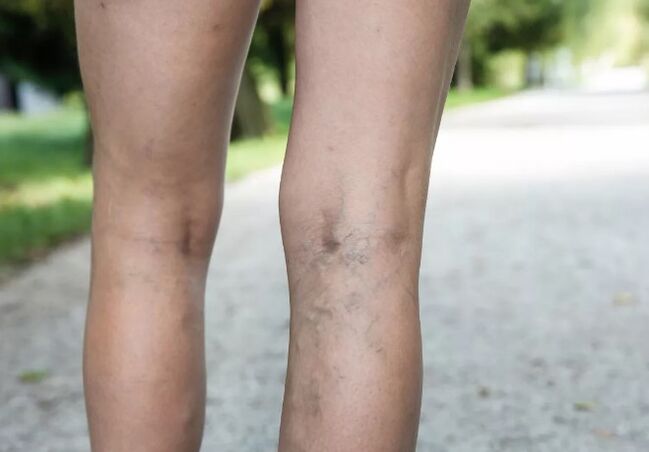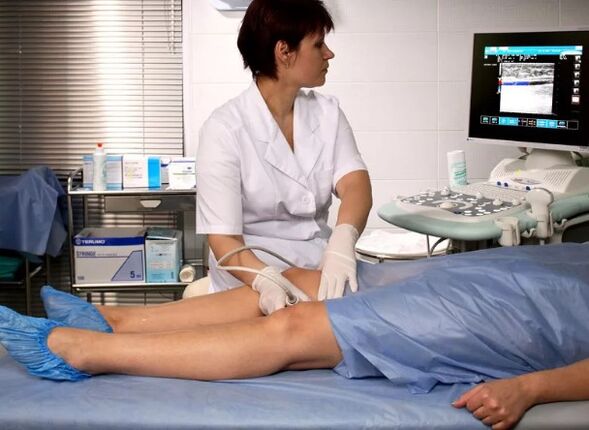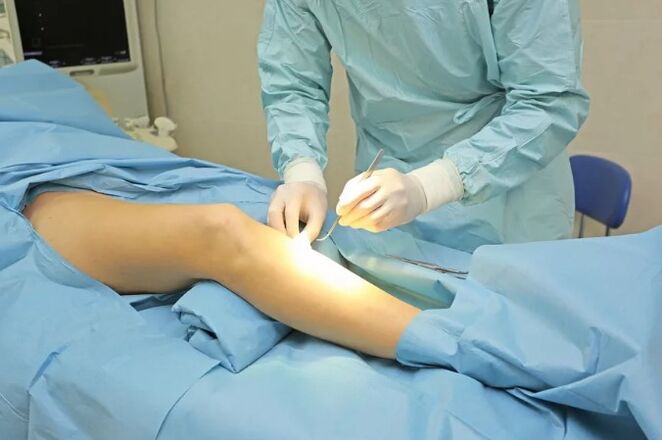Varicose veins on the legs are a specific expansion of the veins of the lower extremities, which is accompanied by a general violation of blood flow and valve failure. The expansion of the veins is characteristic of women and men between the ages of 40 and 60.

Development mechanism
The trigger in the development of such a pathology as varicose veins is regarded as a violation of the normal operation of the venous flaps with the occurrence of blood outflow (reflux - reverse electricity). At the cellular level, this is associated with a violation of the balance between some components of the venous wall.
The initial stage is characterized by the presence of a genetic and causal factor (longer stay in a seated position, overweight, injury, etc. ). At the same time, the so-called shear stress parameter parameter, which is a number of blood movement indicators through the vessels, is very sensitive to which endothel is reacting.
If the irritating factor acts on the wall of the vessel for a long time, the leukocytes are firmly defined at the endothelial cells that cause the initial stage of inflammation. The inflammatory process spreads through the venous channel of the lower extremities.
Such processes are particularly quickly occurring in valves that are exposed to constant, strong mechanical voltage. However, inflammation on one leg can be more pronounced than on the other. First, it depends on the initial cause of damage to the organ, for example on the right leg, varicose veins can be more pronounced on athletes.
In the event of damage to the flaps, a pathological blood discharge is carried out by the mouth of a large and small subcutaneous vein. Due to the restart, an excess blood flow, the wall of venous vessels occurs.
Over time, dynamic venous hypertension, which is characterized by a decrease in pressure in the vessel, develops, this usually occurs when walking the impossibility of ensuring normal blood perfusion through the tissue.
Such a process is accompanied by edema, the subcutaneous tissue impregnated with blood cells (red blood cells and leukocytes). Over time, the skin changes its color, swelling, skin pigmentation is improved. With the death of cells, which is not indecent during medical care, which continues to develop trophic ulcers.

Classification of varicose veins
From 2000 a new classification of varicose veins of the lower extremities was developed.
Forms of varicose veins:
- Intradermal or segmental varicose veins without pathological changes;
- Segmental varicose veins with superficial vein reeflux;
- Common varicose veins of the surface veins;
- Cramp expansion in the presence of deep vein reeflux.
The degree of chronic venous insufficiency:
- 0 - does not develop;
- I - syndrome of "heavy legs", the appearance of edema;
- II - persistent edema, eczema, lipodermose mosquerosis;
- III - Trophic ulcer.
Complications of venous expansion of the veins of the lower extremity are one of the serious diseases that affect the body: thrombophlebitis, trophic ulcers, erysipelas, erysipelas or bleeding.
Working classification of the disease
According to form:
- Varicose veins of the subcutaneous vein of the thigh (out of the mouth) - descending varicose veins;
- Rising varicose veins (defeat of the WEN, lower leg and feet, starting from the bottom up);
From clinical groups:
- The first group is a segmental internal expansion of veins without perforators.
- The second group is the expansion of fragments of venous tribes;
- The third group is the expansion of the subcutaneous vein of the thigh and lower leg;
- The fourth group is a spasm extension of a large and small subcutaneous vein with insolvent perforators;
- The fifth group is the expansion of surface veins, a large and small subcutaneous vena with fabric digestion.
The workers' classification by complications and the degree of chronic failure do not differ from the standard.
The reasons for the development of varicose veins
The exact reason for the development of this pathology has not yet been fully clarified, but there are a number of factors that contribute to the occurrence of varicose veins:
- Genetic predisposition (the mutation gene responsible for the structure of the wall of the vessel is transferred);
- Changes in the hormonal background (pregnancy - during pregnancy, the composition of hormones in physical changes (the amount of progesterone increases and estrogen decreases), which directly influences the formation of blood coagulation factors);
- Obesity (overweight leads to a seated lifestyle and consequently to a collapse);
- Diabetes mellitus (increased blood sugar in time damages the vessel wall over time);
- Alcohol abuse (a large amount of alcohol in the blood is the cause of dehydration and blood condensation);
- severe physical activity;
- Congenital blood clotting disorders;
- irrational nutrition, mistakes in nutrition;
- Instructible and tight underwear (constant wearing leads to compression of blood vessels);
- Frequent constipation (increased intra -abdominal pressure leads to a difficult blood drainage in the lower limbs);
- Constant walking in heels (development of stagnation and inadequate muscle movement);
- Increased air temperature (leads to dehydration, blood thinning and consequently to the formation of blood clots);
- Diseases of the cardiovascular system and kidneys;
- Overdose with medication that increases blood clotting;
- Surgical interventions (blood loss, vascular compression).

Stadiums of varicose veins
For this time of the development of medicine, three main stages of the development of varicose veins and the early stage are distinguished when the disease is very difficult to notice.
The early stage of the disease is accompanied by swelling, weight, very often sickly complained that the legs hurt during a long walk. These are all signs of the beginning of pathology, it is time to start with prevention - massage, leg creams, physical activity.
The expansion of the veins of the 1st degree.This level is characterized by all the symptoms listed above, to which vascular stars, bruises on the legs, knotted veins that are visible through the skin are added. In addition, the appearance of cramps at night and burning in the stop area has been determined.
The expansion of the veins of the 2nd degree.At this stage, the total number of stars and knots increases, they become clearer. Swelling appears, the pain in the legs increases and it becomes unbearable to endure it.
The expansion of the veins of the 3rd degree. This is the most difficult of the stage accompanied by heavy skin lesions of the legs, it becomes dry, lifeless and cracked. The skin of the lower leg becomes dark blue, its structure and pigmentation change.
The third stage is the last if this pathological process can be called varicose veins. The subsequent development of processes stops more serious diseases.
It is advisable to consult a doctor in the second stage of the development of the disease, since medical care fulfills over time.
The question immediately arises: "In which doctor will he go? ", According to the answer, a doctor who specializes in the pathology of the veins of the lower extremities is referred to as a plegologist.

Symptoms and clinic varicose veins
The leading signs of this disease are numerous extensions of subcutaneous veins, which is why the disease is called. The beginning of the disease is usually accompanied by some and non -specific characteristics.
In this state, the patients feel the severity in their legs, a quick tiredness during movement, sometimes burning and cramps. In addition to pain, the disease manifests itself through edema, which develops after a hard working day in the late afternoon.
Symptoms such as eczema and itching occur with a long varicose vein. Patients scratch their legs and create unpleasant sensations. Due to the development of the disease, the skin over the veins is constantly combed, itchy places are constantly combed, which leads to the appearance of wounds.
Over time, the skin color in the lower leg becomes bluish. If no medical care is provided in such a situation, the development of skin hyperpigmentation and lipodermasclerosis is possible. Trophic ulcers develop in even more advanced stages.
Diagnosis of the disease
Varianly expanded veins are visible and are not armed with an armed look. How dangerous this condition must be found using instrumental diagnostic methods.
The most informative method is currently the ultrasound method of the duplex scan of the veins. With its help, it is evaluated based on the operation of the valves, the cross -country capacity and the presence of blood clots. A timely examination of the veins avoids severe and irreversible consequences.
Treatment methods
How do you treat varicose veins? Surgical interventions are only possible with the help of surgical interventions varicose veins. People with an inherited disposition or risk factors recommend visiting a specialist 2-3 times a year. For the ultrasound examination of veins, the operation of varicose veins in the second stage is prescribed for the development of the disease.
How much does the company cost? The price can be committed differently, everything depends on the severity of the development of the disease.

Surgical treatment
Fleet
Indications for the removal of veins: extensive varicose veins, pathological expansion of subcutaneous veins, trophic ulcers, acute thrombophlebitis, expansion of deep veins, accompanied by general malaise (fatigue, dizziness).
Contraindications for the disease: coronary heart disease, pregnancy, older age, serious infectious diseases, inflammatory processes.
The advantage of surgical treatment is that this is the only effective treatment method in advanced forms of disease.
The disadvantage of this treatment: trauma, anesthesia, a long postoperative period.
Laser therapy (EVVK)
Indications: Varicose veins on the legs in combination with various serious diseases (ischemia, thrombophlebitis, asthma, bronchitis, pleuritis, ulcer, cholecystitis, pyelonephritis, peritonitis, dermatitis and chefs).
Laser treatment is contraindicated in cases in which oncology, liver diseases, kidneys, heart (stage of decompensation), pregnancy and brain sclerosis.
The advantages of such treatment is to get rid of the vascular pattern, the maximum fast process, painless and safe, no inpatient observation and atraumatic.
Disadvantages: not available, expensive, the appearance of scars or clarification of the surrounding substance is possible.
Radio frequency coagulation of varicose veins
Indications: Varicose veins with damage to the tribe of a small and large subcutaneous vena, trophic ulcers.
Contraindications: acute form of thrombophlebitis, mental disorders, pregnancy.
Advantages: Painlessness, hospitalization is not necessary after the operation, the work does not bother.
Disadvantages: expensive procedures.
Sclerotherapy
Indications: varicose veins in the early stages.
Contraindications: pregnancy, breastfeeding, allergic reaction to scleros anti, purulent anti -inflammatory processes of legs, thrombosis.
The advantages of this treatment method are that financially such treatment is cheaper than surgery, quick recovery, the best cosmetic effect.
Disadvantages: Perhaps it is not enough to get into the deep veins of the sclerosant, with advanced forms of the disease.
Drug treatment
Medicinal treatment helps improve blood vessels, the condition of the flaps, improves blood and lymph flow and also eliminates inflammation, but does not heal the patient.
How do you treat?

All necessary products from varicose veins are divided into:
- Phlebotonics;
- not steroidal analgesics;
- Hormonic drugs;
- AntiTromboid;
- Aspirin -based drugs.
Home treatment
Traditional medicine ensures the use of various ointments, lotions, tinctures, feet or decoctions.
Apple vinegar treatment varicose veins. However, it is impossible to heal such a disease with referendums in order to relieve the symptoms quite real, especially in the early stages of development. For this purpose, apple cider vinegar is used for wraps, wiping, oral administration or compresses.
How do you avoid diseases?
A sedentary lifestyle, standing work, pregnancy is a greater burden in which an illness such as varicose veins develops.
Varicosis in women is the same problem as cellulite, so special creams, lotions, compression stockings and lymphatic drainage were developed to combat them.
According to statistics, varicose veins are extremely rare in men, and even if much slower develops.
Can I do sports?
Varicosis and running are two factors that always go nearby. The most effective prevention of the expansion of the veins of one of the levels is constant physical exertion: running, gymnastics, various strength exercises on the legs, bicycles and so on.
There are a number of simple exercises to improve blood flow and prevent varicose veins:
- The rotation of the foot in clockwise 20 times in each direction.
- Work with your fingers. Extend fingers 20 times and stick.
- Stars on socks, then on the heels and after you were withdrawn from your heels to socks and 20 to 30 times.

























